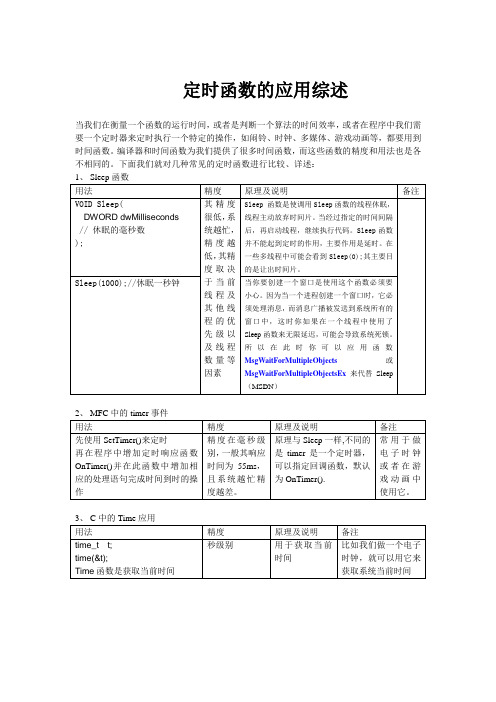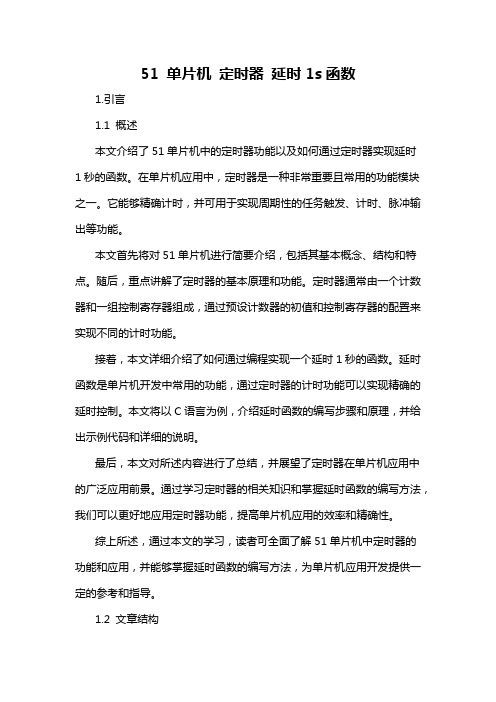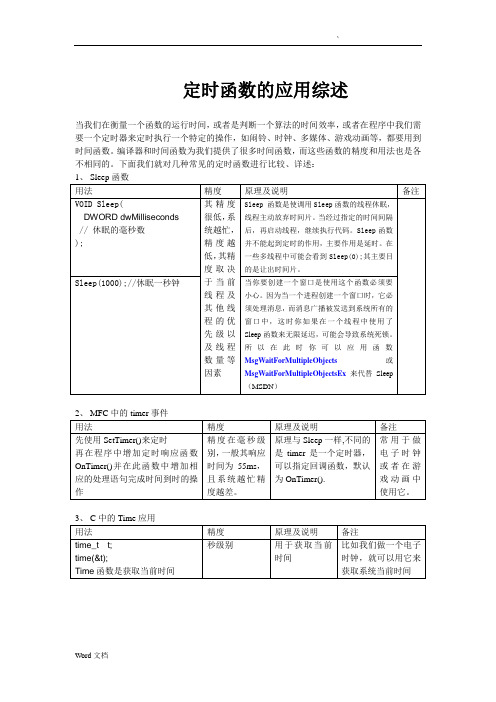定时器常用函数
定时函数的应用综述

定时函数的应用综述
当我们在衡量一个函数的运行时间,或者是判断一个算法的时间效率,或者在程序中我们需要一个定时器来定时执行一个特定的操作,如闹铃、时钟、多媒体、游戏动画等,都要用到时间函数。
编译器和时间函数为我们提供了很多时间函数,而这些函数的精度和用法也是各不相同的。
下面我们就对几种常见的定时函数进行比较、详述:
小结:以上提到的9种时间函数,由于他们的用处不同,其精度也有很大的差异,用户可以根据不同的需求选择合适的时间函数。
本文原始资料来源于网络,经个人加工形成,有些函数由于没有经过自己的测试,资料不一定准确,在选择了具体的函数之后,使用时尚须查阅该函数具体的资料。
我在程序中使用过的函数举例:
1:Sleep(1000)
//延时1s,多用于多线程程序中,如果在单个线程的程序中使用,有类似死机现象。
2、Timer事件:
该函数使用比较简单,但由于其精度与系统繁忙程度有关,在不需精确定时的场合应用非常好用,但如果需要精确定时,建议不要使用;
(1)定时setTimer(1,1000,NULL)//为定时器一设置一个1秒的周期
(2)在应用程序中添加OnTime()
{
CDC * pDC;
pDC->TextOut(100,100,“This is a test!”);
}//消息响应函数,在该函数中处理你想有响应的事件。
运用Windows定时器队列实现高精度定时

运用Windows定时器队列实现高精度定时0 引言在软件开发过程中,定时器是一种常用的设计元素。
Windows 平台上的定时器编程有多种实现方式,比较常用的有:SetTimer()实现的定时器、timeSetEvent()函数实现的多媒体定时器、可等待定时器(Waitable timer)、相关的Windows API函数结合循环采用轮询机制实现的定时功能,以及定时器队列定时器(Timer-queue timer)等。
SetTimer()函数可以为Windows 程序分配一个定时器,该定时器利用WM_TIMER 消息映射来进行简单的时间控制,定时精度约为55ms.由于Windows系统采用多线程的抢占式多任务工作方式,而WM_TIMER消息优先级较低,因此这种定时方法适用于对定时精度要求不高的情况。
Delphi、VB等快速原型化开发工具中自带的定时器控件,基本上都是采用该方法实现的。
除了定时精度低以外,VB的定时器控件有更大的缺陷,其定时间隔不能超过65535ms,更限制了这样的定时器控件的应用。
与SetTimer()函数实现的定时器相比,timeSetEvent()实现的多媒体定时器,可以实现多分辨率的定时,分辨率越高,定时精度越高,但系统所需的开销越重。
该函数可以实现只进行一次性的定时事件出发,也可以进行常规的周期性定时,因此该方法的应用比较灵活,但出于种种原因,微软在MSDN中明确指出,该函数已被摒弃,在应用程序开发过程中不应再使用该方法进行定时。
Windows 中很多与时间相关的API 函数可以与循环结合,采用轮询机制实现定时功能。
典型的API函数有GetTickCount()、timeGetTime()、QueryPerformanceFrequency ()和QueryPerformanceCounter()。
GetTickCount()和timeGetTime()都是获取自系统启动以来流逝的秒数,结合循环,获取两次调用之间的差值即可实现定时。
51 单片机 定时器 延时1s函数

51 单片机定时器延时1s函数1.引言1.1 概述本文介绍了51单片机中的定时器功能以及如何通过定时器实现延时1秒的函数。
在单片机应用中,定时器是一种非常重要且常用的功能模块之一。
它能够精确计时,并可用于实现周期性的任务触发、计时、脉冲输出等功能。
本文首先将对51单片机进行简要介绍,包括其基本概念、结构和特点。
随后,重点讲解了定时器的基本原理和功能。
定时器通常由一个计数器和一组控制寄存器组成,通过预设计数器的初值和控制寄存器的配置来实现不同的计时功能。
接着,本文详细介绍了如何通过编程实现一个延时1秒的函数。
延时函数是单片机开发中常用的功能,通过定时器的计时功能可以实现精确的延时控制。
本文将以C语言为例,介绍延时函数的编写步骤和原理,并给出示例代码和详细的说明。
最后,本文对所述内容进行了总结,并展望了定时器在单片机应用中的广泛应用前景。
通过学习定时器的相关知识和掌握延时函数的编写方法,我们可以更好地应用定时器功能,提高单片机应用的效率和精确性。
综上所述,通过本文的学习,读者可全面了解51单片机中定时器的功能和应用,并能够掌握延时函数的编写方法,为单片机应用开发提供一定的参考和指导。
1.2 文章结构本文以51单片机定时器功能为主题,旨在介绍如何使用定时器进行延时操作。
文章分为引言、正文和结论三个主要部分。
在引言部分,首先会对文章的背景进行概述,介绍单片机的基本概念和应用领域。
然后,给出本文的整体结构,并阐述文章的目的和意义。
正文部分将分为两个小节。
在2.1节中,将对单片机进行详细介绍,包括其构造与工作原理。
这部分的内容将帮助读者全面了解单片机的基本知识,为后续的定时器功能介绍打下基础。
2.2节将重点介绍定时器的功能和特点。
这部分将涵盖定时器的基本原理、工作模式以及在实际应用中的使用方法。
同时,还将详细讲解如何使用定时器进行1秒钟的延时操作,包括具体的代码实现和注意事项。
结论部分将对全文进行总结,并强调定时器的重要性和应用前景。
c标准库定时器函数

C标准库定时器函数==========在C标准库中,定时器函数提供了一种在特定时间间隔后触发事件或者在某个时间点执行特定任务的能力。
以下是一些主要的C标准库定时器函数及其功能:1. 创建/删除定时器-----------* `timer_create`:此函数用于创建一个新的定时器。
它需要一个`timer_t`类型的变量来存储定时器的标识符,一个`struct sigevent`结构体来指定定时器的回调函数和参数,以及一个`timer_attr_t`类型的变量来指定定时器的属性。
* `timer_delete`:此函数用于删除一个已创建的定时器。
它需要一个`timer_t`类型的变量来存储定时器的标识符。
2. 定时器控制--------* `timer_settime`:此函数用于设置定时器的运行参数,包括定时器的标识符、定时器类型(周期性或单次)、回调函数、回调函数的参数、初试时间、间隔时间等。
* `timer_gettime`:此函数用于获取定时器的当前状态,包括定时器的标识符、当前时间、剩余时间等。
3. 定时器回调--------* `timer_cb`:此函数是定时器的回调函数,它会在定时器触发时被调用。
在回调函数中,您可以执行任何需要在特定时间执行的任务。
4. 定时器状态获取----------* `timer_status`:此函数用于获取定时器的状态,包括定时器的标识符、当前时间、剩余时间、状态标志等。
这些函数的使用需要结合具体的程序设计和需求来进行。
使用这些函数时需要注意错误处理和异常情况的处理,以确保程序的稳定性和可靠性。
定时函数的应用综述

定时函数的应用综述
当我们在衡量一个函数的运行时间,或者是判断一个算法的时间效率,或者在程序中我们需要一个定时器来定时执行一个特定的操作,如闹铃、时钟、多媒体、游戏动画等,都要用到时间函数。
编译器和时间函数为我们提供了很多时间函数,而这些函数的精度和用法也是各不相同的。
下面我们就对几种常见的定时函数进行比较、详述:
小结:以上提到的9种时间函数,由于他们的用处不同,其精度也有很大的差异,用户可以根据不同的需求选择合适的时间函数。
本文原始资料来源于网络,经个人加工形成,有些函数由于没有经过自己的测试,资料不一定准确,在选择了具体的函数之后,使用时尚须查阅该函数具体的资料。
我在程序中使用过的函数举例: 1:Sleep(1000)
//
延时1s ,多用于多线程程序中,如果在单个线程的程序中使用,有类似死机现象。
2、Timer 事件:
该函数使用比较简单,但由于其精度与系统繁忙程度有关,在不需精确定时的场合应用非常好用,但如果需要精确定时,建议不要使用;
(1) 定时 setTimer(1,1000,NULL)//为定时器一设置一个1秒的周期 (2) 在应用程序中添加OnTime() {
CDC * pDC;
pDC->TextOut(100,100,“This is a test!”);
}//消息响应函数,在该函数中处理你想有响应的事件。
3、TimeSetEvent()函数。
定时器计数器常用编程方法

定时器计数器常用编程方法定时器计数器是编程中常用的工具,它们可以用于控制程序的执行时间、测量时间间隔、产生脉冲信号等。
以下是一些常用的编程方法来使用定时器计数器:1. 硬件定时器/计数器:许多微控制器和处理器都内置了硬件定时器/计数器。
这些定时器/计数器可以用于产生精确的时间延迟或测量时间间隔。
在编程时,通常需要配置定时器/计数器的参数,如计数频率、计数值等,然后启动定时器/计数器,让它自动计数或计时。
2. 软件定时器/计数器:如果硬件没有提供定时器/计数器,或者需要更灵活的控制,可以使用软件定时器/计数器。
软件定时器/计数器是通过程序代码实现的,通常使用循环和延时函数来模拟定时或计数。
这种方法不如硬件定时器/计数器精确,但可以实现简单的定时和计数功能。
3. 操作系统提供的定时器/计数器:许多操作系统都提供了定时器和计数器的API或功能。
例如,在Windows系统中,可以使用CreateTimerQueueTimer函数创建一个定时器,用于在指定的时间间隔后触发回调函数。
在Linux系统中,可以使用alarm或setitimer函数设置定时器。
这些方法通常需要结合操作系统提供的API进行编程。
4. 第三方库或框架:许多编程语言和框架提供了对定时器和计数器的支持。
例如,Python中的time模块提供了sleep函数用于暂停程序执行一段时间,而Tkinter库提供了Timer类用于在GUI应用程序中创建定时器。
这些库或框架通常提供更高级的功能和更灵活的控制,但需要学习和使用特定的API或语法。
总之,使用定时器计数器的编程方法有很多种,具体选择哪种方法取决于应用程序的需求和使用的编程语言或框架。
linux timer用法

linuxtimer用法Linux操作系统提供了丰富的定时器功能,通过使用Linux定时器,可以轻松地实现定时任务、周期性执行的操作等。
本文将介绍Linux定时器的用法,包括定时器的类型、创建、使用和销毁等。
一、定时器类型Linux定时器可以分为以下几种类型:1.软定时器:软定时器是一种基于时间的定时器,可以通过系统调用实现定时任务。
软定时器的时间单位可以是秒、毫秒、微秒等,可以根据实际需求选择合适的单位。
2.硬定时器:硬定时器是一种基于内核定时器的定时器,可以通过内核提供的定时器接口实现周期性执行的操作。
硬定时器的精度较高,可以根据实际需求选择合适的精度。
二、创建定时器创建定时器可以通过系统调用来实现,具体方法如下:1.软定时器创建:可以使用`timer_create()`函数创建一个软定时器,该函数需要指定定时器的名称、指向定时器回调函数的指针、定时器的超时时间等信息。
创建成功后,会返回一个定时器的标识符,可以使用该标识符来控制定时器的执行。
2.硬定时器创建:可以使用`timer_create()`函数创建一个硬定时器,该函数需要指定定时器的名称、指向定时器回调函数的指针、定时器的起始时间等信息。
创建成功后,内核会根据指定的精度周期性地执行回调函数。
三、使用定时器创建了定时器后,需要使用该标识符来控制定时器的执行。
可以使用`timer_set_state()`函数来设置定时器的状态为运行或停止。
可以使用`timer_start()`函数来启动定时器,使定时器进入运行状态;可以使用`timer_try_stop()`函数来尝试停止当前运行的定时器。
需要注意的是,硬定时器不能被取消或延迟执行,只能被重新设置起始时间。
四、销毁定时器定时器执行完毕或不再需要时,需要销毁该定时器。
可以使用`timer_delete()`函数来销毁软定时器,使用`timer_delete(timerfd)`函数来销毁硬定时器。
定时器函数

定时器函数
定时器函数是一种常用的编程方法,它可以在一定时间间隔内执行指定的代码。
在JavaScript中,常用的定时器函数有setTimeout 和setInterval。
setTimeout函数可以让指定的代码在一定时间后执行一次,语
法如下:
setTimeout(function, milliseconds);
其中,function是要执行的代码,以函数的形式传入;milliseconds是延迟的时间,以毫秒为单位。
setInterval函数可以让指定的代码在一定时间间隔内重复执行,语法如下:
setInterval(function, milliseconds);
其中,function和milliseconds的含义与setTimeout函数相同。
使用定时器函数时,需要注意以下几点:
1. 执行的代码必须以函数形式传入
2. 延迟时间或时间间隔必须是整数,单位为毫秒
3. 可以通过clearTimeout和clearInterval函数取消定时器的执行
定时器函数在前端开发中非常常见,可以用于实现动画效果、轮播图、计时器等功能。
但需要注意,滥用定时器函数可能会导致性能问题,因此应该合理使用并避免过度依赖。
micropython timer参数

Micropython是一种在微控制器上运行的Python3解释器。
在Micropython中,我们常常会使用定时器来执行一些定时任务或者进行一些时间相关的操作。
而在使用定时器时,不可避免地会涉及到一些参数的设置。
本文将主要介绍Micropython中定时器的参数设置,以及这些参数在实际使用中的一些注意事项。
一、定时器的基本概念在Micropython中,定时器是一个用于定时执行函数或者操作的工具。
它可以在指定的时间间隔内进行重复执行,也可以在一定延时后执行一次。
在Micropython中,常用的定时器有两种:硬件定时器和软件定时器。
硬件定时器是由微控制器内部的硬件模块提供的,其精度高但数量有限。
而软件定时器则是由软件系统自行实现的,其数量可以任意增加,但精度相对较低。
不同的定时器在Micropython中有不同的参数设置方式和使用方法。
接下来我们将重点介绍硬件定时器的参数设置。
二、定时器参数的设置在Micropython中,硬件定时器的参数设置主要包括定时器编号、定时器时钟源、定时器预分频器、定时器周期值、定时器工作模式等。
下面我们将分别介绍这些参数的设置方法。
1. 定时器编号在Micropython中,每个硬件定时器都有一个唯一的编号,用于在程序中进行区分。
在使用定时器之前,我们需要确定所要使用的定时器的编号,然后在程序中进行相应的设置。
不同的微控制器对定时器编号的命名方式有所不同,如ESP32中的定时器编号为0-3,而STM32中的定时器编号则为1-14等。
在继续进行其他参数设置时,我们需要首先明确所要操作的定时器编号。
2. 定时器时钟源定时器时钟源用于确定定时器的时钟信号来源,不同的时钟源对应着不同的工作频率。
在Micropython中,常用的定时器时钟源包括内部时钟源和外部时钟源。
内部时钟源是由微控制器内部的时钟模块提供的,其工作频率相对稳定;而外部时钟源则是由外部的晶振模块提供的,其工作频率通常更高,但相对不太稳定。
linux定时器用法

linux定时器用法
在Linux系统中,有多种方法可以使用定时器。
下面是几种常用的定时器用法:
1. 使用timer_create和timer_settime函数创建和设置定时器。
这种方法允许您创建一个新的定时器,并设置它的超时时间和触发事件等。
可以使用timer_gettime函数来获取定时器的当前状态。
2. 使用setitimer函数来设置实时定时器。
该函数可以设置定时器的超时时间和触发事件,并且可以使用getitimer函数获取定时器的当前状态。
3. 使用alarm函数设置一个单次定时器。
该函数可以设置一个超时时间,并在超时后触发一个SIGALRM信号。
4. 使用poll或select等I/O多路复用函数来实现定时器功能。
可以将超时时间作为参数传递给这些函数,并在超时后触发相应的事件。
这些方法中的每一种都有不同的用法和适用场景。
具体使用哪种方法取决于您的需求和编程环境。
setinterval执行方法

setinterval执行方法【原创版4篇】目录(篇1)I.定时器(setinterval)执行方法介绍II.定时器(setinterval)执行方法的应用场景III.定时器(setinterval)执行方法的优缺点IV.定时器(setinterval)执行方法的实现原理正文(篇1)I.定时器(setinterval)执行方法介绍定时器是一种在指定时间间隔内重复执行某个操作的机制。
在JavaScript中,可以使用setInterval()方法来实现定时器功能。
该方法接受两个参数:要执行的函数和时间间隔。
该方法会返回一个计时器ID,可以通过该ID来停止定时器。
II.定时器(setinterval)执行方法的应用场景定时器(setinterval)执行方法在网页开发中有着广泛的应用场景。
例如,可以实现定时任务、倒计时、动画效果等。
通过使用定时器,可以轻松地实现一些复杂的交互效果,提高用户体验。
III.定时器(setinterval)执行方法的优缺点优点:1.简单易用:setInterval()方法可以很方便地实现定时器功能,只需要传递一个函数和一个时间间隔即可。
2.灵活性强:可以根据需要设置不同的时间间隔,也可以根据实际需求修改时间间隔。
3.可控性强:可以通过返回的计时器ID来停止定时器,方便地控制定时器的执行。
缺点:1.占用CPU资源:由于需要不断执行定时器函数,会占用一定的CPU 资源,可能会导致页面卡顿。
2.不适合高频率操作:由于定时器的精度限制,频繁的定时器操作可能会导致性能问题。
3.不适合长时间运行:由于JavaScript在页面关闭时会停止执行,长时间运行的定时器可能会被停止。
IV.定时器(setinterval)执行方法的实现原理setInterval()方法实际上是通过创建一个定时器对象来实现的。
该对象包含一个计时器和一个回调函数。
当计时器达到指定的时间间隔时,会触发回调函数,并重新开始计时。
stm32hal库函数说明手册

stm32hal库函数说明手册(原创实用版)目录一、STM32HAL 库概述二、STM32HAL 库常用函数说明1.GPIO 操作相关函数2.中断处理相关函数3.串行通信相关函数4.定时器操作相关函数5.输入输出相关函数三、STM32HAL 库函数使用示例四、总结正文一、STM32HAL 库概述STM32HAL 库是 STM32 微控制器的官方软件库,它提供了丰富的功能,包括 GPIO 操作、中断处理、串行通信、定时器操作和输入输出等。
使用STM32HAL 库可以简化程序开发,提高开发效率。
本篇文章将对 STM32HAL 库的常用函数进行说明,并给出使用示例。
二、STM32HAL 库常用函数说明1.GPIO 操作相关函数GPIO(通用输入输出)是 STM32 微控制器中最常用的功能之一。
以下是几个常用的 GPIO 函数:- `halgpioinit()`:GPIO 初始化函数,用于配置 GPIO 的引脚模式、输出类型、速度等。
- `halgpiowrite()`:用于设置或清除 GPIO 引脚的状态。
- `halgpioread()`:用于读取 GPIO 引脚的状态。
- `halgpioexticallback()`:中断回调函数,用于处理 GPIO 外部中断事件。
2.中断处理相关函数中断是 STM32 微控制器中常用的功能,可以用于处理各种外部事件。
以下是几个常用的中断处理函数:- `hal_nvic_init()`:NVIC(嵌套中断向量列表控制器)初始化函数,用于配置 NVIC 的相关参数。
- `hal_nvic_irqHandler()`:NVIC 中断处理函数,用于处理 NVIC 中的中断请求。
- `hal_nvic_irqEnable()`:用于启用 NVIC 中的某个中断。
- `hal_nvic_irqDisable()`:用于禁用 NVIC 中的某个中断。
3.串行通信相关函数串行通信是 STM32 微控制器中常用的功能,以下是几个常用的串行通信函数:- `haluart_init()`:UART(通用异步收发器)初始化函数,用于配置 UART 的相关参数。
js定时器的使用(实例讲解)

js定时器的使⽤(实例讲解)在javascritp中,有两个关于定时器的专⽤函数,分别为:1.倒计定时器:timename=setTimeout("function();",delaytime);2.循环定时器:timename=setInterval("function();",delaytime);第⼀个参数“function()”是定时器触发时要执⾏的动作,可以是⼀个函数,也可以是⼏个函数,函数间⽤“;”隔开即可。
⽐如要弹出两个警告窗⼝,便可将“function();”换成“alert('第⼀个警告窗⼝!');alert('第⼆个警告窗⼝!');”;⽽第⼆个参数“delaytime”则是间隔的时间,以毫秒为单位,即填写“5000”,就表⽰5秒钟。
倒计时定时器是在指定时间到达后触发事件,⽽循环定时器就是在间隔时间到来时反复触发事件,两者的区别在于:前者只是作⽤⼀次,⽽后者则不停地作⽤。
⽐如你打开⼀个页⾯后,想间隔⼏秒⾃动跳转到另⼀个页⾯,则你就需要采⽤倒计定时器“setTimeout("function();",delaytime)”,⽽如果想将某⼀句话设置成⼀个⼀个字的出现,则需要⽤到循环定时器“setInterval("function();",delaytime)” 。
获取表单的焦点,则⽤到document.activeElement.id。
利⽤if来判断document.activeElement.id和表单的ID是否相同。
⽐如:if ("mid" == document.activeElement.id) {alert();},"mid"便是表单对应的ID。
定时器:⽤以指定在⼀段特定的时间后执⾏某段程序。
JS中定时执⾏,setTimeout和setInterval的区别,以及l解除⽅法setTimeout(Expression,DelayTime),在DelayTime过后,将执⾏⼀次Expression,setTimeout 运⽤在延迟⼀段时间,再进⾏某项操作。
timer_gettime用法,请举例

Python定时器是一种用于安排函数或其他代码在指定时间或间隔执行的工具。
它通常用于在后台执行任务,例如发送电子邮件或更新数据库。
Python中内置了多种定时器,包括:time.sleep():使当前线程休眠指定的时间,单位为秒。
threading.Timer():创建一个新的线程,并在指定的时间后运行给定的函数。
sched.scheduler():一个更强大的定时器,允许您安排函数在特定时间或间隔执行。
time.sleep()是最简单和最常用的定时器。
它可以被用来暂停程序的执行一段时间。
例如,以下代码将使程序休眠5秒:pythonimport timetime.sleep(5)threading.Timer()可以用来在后台运行函数。
它将创建一个新的线程,并在指定的时间后运行给定的函数。
例如,以下代码将在5秒后打印"Hello, world!":pythonimport threadingdef hello():print("Hello, world!")t = threading.Timer(5, hello)t.start()sched.scheduler()是一个更强大的定时器,允许您安排函数在特定时间或间隔执行。
它可以用来创建复杂的定时器任务。
例如,以下代码将在每5秒打印"Hello, world!":pythonimport scheddef hello():print("Hello, world!")s = sched.scheduler()s.enter(5, 1, hello)s.run()Python定时器可以用来执行各种各样的任务。
它们可以用来在后台发送电子邮件、更新数据库或执行其他任何需要定时完成的任务。
settimercyclic用法

文章标题:深度解析settimercyclic的用法及应用在计算机编程领域中,settimercyclic是一个非常常用的函数,在各种系统编程中都有着广泛的应用。
它是一个用于设置周期性定时器的函数,能够在指定的时间间隔内定时执行某个任务或函数。
在本文中,我将深入探讨settimercyclic的用法及其在实际应用中的价值和意义。
1. 什么是settimercyclic?settimercyclic是一个函数,它可以在指定的时间间隔内周期性地执行某个动作。
它通常由系统提供,并可以通过系统调用的方式来调用。
通过设置参数,我们可以指定定时器的间隔时间、需要执行的动作或函数等信息,从而实现定时任务的功能。
2. settimercyclic的基本用法在使用settimercyclic时,我们首先需要创建一个定时器对象,并设置其参数,包括间隔时间、定时执行的动作等。
我们需要将定时器启动,这样它才能开始按照设定的时间间隔来执行相关的动作或函数。
当不再需要定时器时,我们需要将其关闭并释放资源,以避免资源泄漏和系统性能问题。
3. settimercyclic在实际应用中的价值settimercyclic在实际应用中有着非常重要的价值和意义。
它可以帮助我们实现定时任务,比如定时检查系统状态、定时清理垃圾文件等。
它还可以用于实现周期性的数据采集和处理,比如定时从传感器中读取数据、定时更新数据库中的信息等。
settimercyclic可以帮助我们实现一些周期性的、需要按照规律执行的任务,从而提高系统的稳定性、可靠性和效率。
4. 个人观点和理解在我看来,settimercyclic是一个非常强大并且实用的函数。
它不仅可以帮助我们实现一些复杂的定时任务,还可以帮助我们提高系统的性能和可靠性。
在编程中,我经常使用settimercyclic来实现一些特定功能,比如定时扫描目录、定时发送数据等。
我发现,通过合理地设置定时器的参数,可以实现非常精确的定时任务,并且大大减少了系统性能的浪费。
settimeout的用法

settimeout的用法setTimeout是JavaScript中常用的一种定时器函数,它通常用于在一定时间后执行一段代码,被广泛应用于各种Web开发场景中。
本文将详细介绍setTimeout的用法,包括语法、参数、返回值、注意事项等等。
一、语法setTimeout函数的语法非常简单,如下所示:```setTimeout(function, milliseconds, param1, param2, ...)```其中,function是要执行的函数;milliseconds是延迟的毫秒数;param1, param2等是要传递给函数的参数。
具体来说,setTimeout函数接收以下参数:1.第一个参数必须是函数,可以直接传递函数名或者使用匿名函数;2.第二个参数表示延迟的毫秒数,通常为整数类型,可以为0;3.第三个及之后的参数是要传递给函数的参数,可以为任何类型,数量不限。
二、返回值setTimeout函数返回的是一个定时器ID,可以用来取消定时器。
当函数被执行后,定时器ID将被返回,可以通过clearTimeout函数来取消定时器。
例如:三、使用示例1.延迟执行函数执行结果:3秒后,在控制台输出'3秒后执行!'。
2.传递参数```setTimeout(function(name, age) {console.log('我叫' + name + ',今年' + age + '岁');}, 3000, '小明', 18);```3.使用定时器ID取消定时器执行结果:没有任何输出。
注意:当定时器ID被取消之后,函数将不会被执行。
四、注意事项1.setTimeout函数只能在主线程中运行,不能在Web Worker中运行;2.如果函数的执行时间超过延迟时间,也就是说函数执行耗时大于延迟时间,那么函数会在当前执行结束之后立即执行,而不是在超时后再执行;3.如果setTimeout函数被多次调用,而且延迟时间相同,那么函数将按调用的顺序依次执行;4.setTimeout函数的延迟最小时间是4毫秒,如果设置的时间小于4毫秒,那么实际延迟时间将会大于等于4毫秒。
python定时器用法

Python定时器是一种用于安排函数或其他代码在指定时间或间隔执行的工具。
它通常用于在后台执行任务,例如发送电子邮件或更新数据库。
Python中内置了多种定时器,包括:time.sleep():使当前线程休眠指定的时间,单位为秒。
threading.Timer():创建一个新的线程,并在指定的时间后运行给定的函数。
sched.scheduler():一个更强大的定时器,允许您安排函数在特定时间或间隔执行。
time.sleep()是最简单和最常用的定时器。
它可以被用来暂停程序的执行一段时间。
例如,以下代码将使程序休眠5秒:pythonimport timetime.sleep(5)threading.Timer()可以用来在后台运行函数。
它将创建一个新的线程,并在指定的时间后运行给定的函数。
例如,以下代码将在5秒后打印"Hello, world!":pythonimport threadingdef hello():print("Hello, world!")t = threading.Timer(5, hello)t.start()sched.scheduler()是一个更强大的定时器,允许您安排函数在特定时间或间隔执行。
它可以用来创建复杂的定时器任务。
例如,以下代码将在每5秒打印"Hello, world!":pythonimport scheddef hello():print("Hello, world!")s = sched.scheduler()s.enter(5, 1, hello)s.run()Python定时器可以用来执行各种各样的任务。
它们可以用来在后台发送电子邮件、更新数据库或执行其他任何需要定时完成的任务。
setitimer函数

setitimer函数
setitimer函数是Linux系统提供的一个定时器函数,可以用来设置定时器的时长及触发方式。
该函数需要传入三个参数,分别是定时器类型、时间结构体以及旧的时间结构体。
定时器类型包括ITIMER_REAL、ITIMER_VIRTUAL和ITIMER_PROF,分别对应实时定时器、虚拟定时器和CPU时间定时器。
时间结构体包括定时器启动的时间和间隔时间,单位是微秒。
旧的时间结构体用于保存之前的定时器时间设置。
使用setitimer函数可以实现很多定时器相关的功能,比如程序定时退出、定时执行任务、定时刷新界面等。
在多线程编程中,可以利用setitimer函数实现定时器轮询,判断是否需要触发某些操作。
需要注意的是,setitimer函数并非精确的定时器,其触发时间可能会有一定的误差。
此外,在使用ITIMER_VIRTUAL和ITIMER_PROF 定时器时,需要注意定时器的精度会受到进程运行状态的影响。
总之,setitimer函数是Linux系统提供的一种方便、灵活的定时器函数,可以方便地实现各种时间相关的操作。
- 1 -。
qt qtimer用法

qt qtimer用法Qt是一款桌面应用程序开发跨平台的C++库,它可以让开发者构建自己的应用程序,使用更少的代码,更快的速度实现目标。
Qt的QTimer(定时器)是一种用来定时执行任务的精确工具,可以在指定的时间间隔内重复执行某个动作。
QTimer是Qt库中最常用的定时器之一,广泛用于GUI应用程序。
QTimer提供了两种定时器机制:一种是简单的单次计时,另一种是可以多次重复计时。
QTimer默认情况下是启动就运行的,可以通过函数start()来自定义定时器的工作模式、时钟间隔以及在定时器到期时需要执行的动作。
QTimer的基本操作就是设置一定的间隔时间,当时间到达时,定时器会发出一个信号来指示时间已到。
使用QTimer,可以延迟一段时间来执行一些特定的任务,这种机制可以在很多地方使用。
QTimer类的基本用法是:为QTimer对象设置一定的时间间隔,然后使用start()函数启动它;当时间到达指定的间隔时,QTimer对象会发出一个信号,从而触发我们指定的槽函数来执行特定的任务,可以使用timeout()函数来获得它发出的信号,这个信号默认情况下是使用毫秒作为间隔单位;然后,可以用stop()函数停止定时器,也可以使用reset()函数重置定时器,重新设置定时器时间,重新开始计时。
QTimer的实现原理是让应用程序在指定的间隔内处理一个或多个事件,而不是立即运行这些事件。
通常情况下,定时器会在指定间隔结束时被调用。
QTimer可以跟踪应用程序的运行时间,并在指定的时间点启动特定的任务。
QTimer类还提供了一系列的函数来控制定时器的工作模式,比如可以配置定时器的时间间隔、可以重置定时器时间间隔、可以停止定时器等等。
QTimer是一种功能强大的工具,可以实现很多复杂的任务。
例如,可以使用QTimer来实现定时刷新GUI窗口或处理网络请求,可以使用它来实现定时处理数据库操作,可以使用它来实现定时读取文件,定时发送邮件等等,从而实现实时运行程序的功能。
- 1、下载文档前请自行甄别文档内容的完整性,平台不提供额外的编辑、内容补充、找答案等附加服务。
- 2、"仅部分预览"的文档,不可在线预览部分如存在完整性等问题,可反馈申请退款(可完整预览的文档不适用该条件!)。
- 3、如文档侵犯您的权益,请联系客服反馈,我们会尽快为您处理(人工客服工作时间:9:00-18:30)。
在“period”个毫秒后调用“callback”方法一次。返回定时事件的ID。
int oscillate(int pin, long period, int startingValue)
每“period”个毫秒切换数字输出引脚“pin”的状态。引脚的初始值由“startingValue”定义,应为HIGH或LOW。返回定时事件的ID。
int every(long period, callback)
每“period”个毫秒调用“callback”方法。返回定时事件的ID。
int every(long period, callback, int repeatCount)
每“period”个毫秒调用“callback”方法,共“repeatCount”次。返回定时事件的ID。
{
Serial.begin(9600);
int tickEvent = t.every(2000, doSomething);//本语句执行以后2000毫秒执行回调函数
Serial.print("2 second tick started id=");
Serial.println(tickEvent);
int pulse(int pin, long period, int startingValue)
在“period”个毫秒后切换数字输出引脚“pin”的状态一次。引脚的初始值由“startingValue”定义,应为HIGH或LOW。返回定时事件的ID。
int stop(int id)
停止正在运行的定时事件。返回定时事件的ID。
Serial.print("After event started id=");
Serial.println(afterEvent);
}
void loop()
{
t.update();
}
void doSomething()
{
Serial.print("2 second tick: millis()=");
int update()
必须在“loop”中调用。Must be called from 'loop'.它会服务所有与定时器相关的事件。
void setup()执行一次
循环执行void loop()
#include &#vent;
void setup()
pinMode(13, OUTPUT);
ledEvent = t.oscillate(13, 50, HIGH);
Serial.print("LED event started id=");
Serial.println(ledEvent);
int afterEvent = t.after(10000, doAfter);
Serial.println(millis());
}
void doAfter()
{
Serial.println("stop the led event");
t.stop(ledEvent);
t.oscillate(13, 500, HIGH, 5);
}
你最多可以在一个定时器上附加10个事件。
int oscillate(int pin, long period, int startingValue, int repeatCount)
每“period”个毫秒切换数字输出引脚“pin”的状态,共“repeatCount”次。引脚的初始值由“startingValue”定义,应为HIGH或LOW。返回定时事件的ID。
